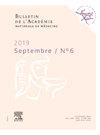Épidémiologie des hémorragies cérébrales spontanées : évolutions depuis 40 ans
IF 0.2
4区 医学
Q3 MEDICINE, GENERAL & INTERNAL
引用次数: 0
Abstract
Les hémorragies cérébrales spontanées, représentant 15 à 25 % des accidents vasculaires cérébraux (AVC), causent 2,9 millions de décès dans le monde chaque année. Pour la période 2017–2022, le taux d’attaque annuel standardisé était de 24,3/100 000 au sein du Registre dijonnais des AVC. Ce taux augmentait avec l’âge. On estimait à 16 400 le nombre de cas chaque année en France. L’incidence a augmenté entre 1985 et 2016 avec une plus grande proportion de patients âgés de plus de 75 et 85 ans. Cette augmentation fut attribuée à davantage d’hémorragies lobaires chez les sujets âgés, probablement en lien avec une augmentation de l’utilisation des antithrombotiques et la prévalence élevée de l’angiopathie amyloïde cérébrale. Une légère diminution des taux d’attaque fut notée durant la période 2017–2022, pouvant traduire des modifications dans l’usage des types d’anticoagulants. Le pronostic vital après une hémorragie cérébrale spontanée reste sombre, avec une létalité à un mois de 38,8 %. Une baisse des taux fut observée entre 1985 et 2011 avant une ré-ascension au cours des années suivantes. Aucune amélioration n’avait été notée concernant la mortalité précoce des 48 premières heures, soulignant l’absence de progrès thérapeutique de phase aiguë. Avec le vieillissement de la population, le nombre de cas annuels pourrait dépasser 24 000 en France en 2050. Cette urgence épidémiologique appelle à améliorer le dépistage et le contrôle de l’hypertension artérielle, facteur de risque principal de la maladie, redéfinir et optimiser les stratégies d’anticoagulation chez les sujets avec fibrillation atriale, et développer de nouvelles approches thérapeutiques multidisciplinaires ciblant les différents acteurs physiopathologiques.
Spontaneous intracerebral hemorrhage account for 15 to 25% of overall strokes, and causes 2.9 million deaths worldwide annually. For the period 2017–2022, the age-standardized annual incidence rate was 24.3 per 100,000 in the Dijon Stroke Registry. This rate increased sharply with age. An estimated 16,400 cases occurred annually in France. The incidence rose between 1985 and 2016, with a greater proportion of patients aged over 75 and 85, which was attributed to an increase in lobar intracerebral hemorrhage among the elderly, likely linked to a greater use of antithrombotic drugs and a high prevalence of cerebral amyloid angiopathy. A slight decline in incidence was noted during the period 2017–2022, potentially reflecting changes in the type of anticoagulants used. Vital outcome of spontaneous intracerebral hemorrhage remains poor, with a one-month case-fatality of 38.8%. A decline in case-fatality was observed between 1985 and 2011, followed by an increase in subsequent years. No improvement in early mortality within the first 48 hours was observed, underscoring the lack of progress in acute therapies. With aging population, the annual number of cases in France could exceed 24,000 by 2050. This epidemiological emergency highlights the need to improve hypertension screening and control — hypertension being the most important risk factor for the condition—, redefine and optimize anticoagulation strategies in patients with atrial fibrillation, and develop new multidisciplinary therapeutic approaches targeting the various pathophysiological mechanisms involved.
自发性脑出血的流行病学:40年的演变
自发性脑出血占中风的15 - 25%,每年造成全球290万人死亡。在2017年至2022年期间,第戎中风登记处的标准年中风率为24.3 /10万人。这一比率随着年龄的增长而增加。据估计,法国每年有16400例病例。发病率上升了1985年至2016年间,有更大比例的老年患者逾75 - 85岁。这种增长是归因于更多出血lobaires老年患者,可能与增加使用抗血栓和高发病率的l’angiopathie脑开口。在2017年至2022年期间,发病率略有下降,这可能反映了抗凝血药物使用的变化。自发性脑出血后的生命预后仍然暗淡,一个月的病死率为38.8%。1985年至2011年间,利率有所下降,但随后几年又回升。在最初48小时内的早期死亡率没有改善,这表明在急性期治疗方面缺乏进展。随着人口老龄化,到2050年,法国每年的病例数可能超过24000例。这种流行病紧急呼吁改善检测和控制高血压的危险因素,主要疾病,重新确定和优化策略d’anticoagulation与治疗房颤患者,并开发新的治疗方法,针对各个生理病理学科。自发性脑出血占中风总数的15%至25%,每年导致全球290万人死亡。在第戎中风登记处,2017 - 2022年期间,年龄标准化的年发病率为每10万人24.3人。这一比率随着年龄的增长而急剧上升。据估计,英国每年发生16400例病例。1985年至2016年期间,75岁至85岁的患者比例增加,这是由于老年人额叶脑内出血增加,可能与抗血栓药物的使用增加和脑淀粉样血管疾病的高患病率有关。在2017年至2022年期间,注意到发病率略有下降,这可能反映了抗凝剂使用类型的变化。自发性脑内出血的重要结果仍然很差,一个月的病例死亡率为38.8%。1985年至2011年间,病例死亡率有所下降,随后几年又有所上升。在最初48小时内观察到早期死亡率没有改善,强调了急性治疗缺乏进展。随着人口老龄化,到2050年,英国每年的病例数量可能超过2.4万例。the need to This煤矿应急要闻和筛选and control—高血压高血压是—the risk factor for the most重要条件,好的and优化anticoagulation strategies in with atrial房颤的患者,and new multidisciplinary开发美国治疗方法调查了pathophysiological不同机制的参与。
本文章由计算机程序翻译,如有差异,请以英文原文为准。
求助全文
约1分钟内获得全文
求助全文
来源期刊
CiteScore
0.50
自引率
33.30%
发文量
189
审稿时长
47 days
期刊介绍:
Rédigé par des spécialistes à l''intention d''une Communauté pluridisciplinaire le Bulletin de l''Académie nationale de médecine est au service de toutes les professions médicales : médecins, pharmaciens, biologistes et vétérinaires ainsi que de l''Administration et des institutions intervenant dans le domaine de la santé.
Les mémoires originaux et les mises au point sur des thèmes d''actualité sont associés au compte rendu des discussions qui ont suivi leur présentation. Les rapports des commissions sur l''éthique médicale l''exercice de la profession les questions hospitalières la politique du médicament et l''enseignement de la médecine justifient les recommandations de l''Académie.

 求助内容:
求助内容: 应助结果提醒方式:
应助结果提醒方式:


